Scottish House Condition Survey: Key Findings 2011
The Scottish House Condition Survey (SHCS) combines both an interview with occupants and a physical inspection of dwellings to build up a picture of Scotland’s occupied housing stock. This is the eighth ‘Key Findings’ report since the SHCS changed to a continuous format in 2003.
5 Housing Quality
5.1 The Scottish Housing Quality Standard
119. Two quality standards are set by the Scottish Government and monitored through the Scottish House Condition Survey.
120. The first is the tolerable standard which is a "condemnatory" standard. In other words, it is not reasonable to expect people to continue to live in a house that falls below it. The tolerable standard was redefined in the Housing (Scotland) Act 2006 and applies to all houses in Scotland. Local authorities have a statutory duty and specific powers to deal with houses that fall below the tolerable standard.
121. The second standard is the Scottish Housing Quality Standard (SHQS) which was announced by the Minister for Communities in February 2004[30]. A target was agreed that all social landlords must ensure that all their dwellings pass the SHQS by 2015. Private owners and private landlords are currently under no obligation to bring their properties up to a standard which meets the SHQS. However the same data is collected and reported for all dwellings to allow comparison across the housing stock.
122. The 2002 SHCS failure rate estimates were produced after the announcement[31]. The 2003/4 survey field work began in October 2003, before the final clarification of the SHQS in July 2004[32]. Thus, the 2002 and 2003/4 surveys did not gather all the data needed to fully assess dwellings against the SHQS. This was rectified for the 2004/5 survey and all later surveys including the 2011 survey.
123. The SHQS is an aggregation of the results from about 60 different programme modules aggregated into 5 higher-level classifications which in turn provide a single pass/fail classification for all dwellings. The 5 higher-level criteria are that the dwelling must be:
- above the statutory tolerable standard;[33]
- free from serious disrepair;
- energy efficient;
- with modern facilities and services;
- healthy, safe and secure.
124. The tolerable standard definition was amended by the Housing (Scotland) Act 2006 to include additional criteria, covering thermal performance and electrical safety[34]. As the amendment was not implemented until April 2009, the results from the 2010 survey were the first year to be based on the amended standard. The change in definition caused the fail rate for the standard to increase from 0.7% in 2009 to 3.9% in 2010.
125. In 2011, 72,000 homes were found to be below tolerable standard (BTS), amounting to 3% of the housing stock (Table 30).
Table 30 Below Tolerable Standard Housing by Tenure and Age of Dwelling
| Below Tolerable Standard | Row Sample | ||||
|---|---|---|---|---|---|
| 000s | Failure by Group | % of BTS Stock | |||
| Tenure | Owner-occupier | 51 | 3.5% | 71% | 2050 |
| LA/other public | 5 | 1.5% | 7% | 464 | |
| HA/co-op | 2 | 0.6% | 2% | 354 | |
| Private-rented | 14 | 5.0% | 20% | 342 | |
| Age of Dwelling | pre-1919 | 35 | 7.8% | 49% | 585 |
| 1919-1944 | 16 | 5.4% | 23% | 420 | |
| 1945-1964 | 9 | 1.8% | 13% | 745 | |
| 1965-1982 | 6 | 1.1% | 9% | 768 | |
| post 1982 | 5 | 0.9% | 7% | 692 | |
| Whole Stock | 72 | 3.0% | 100% | 3210 | |
Source: SHCS 2011
126. 5% of private rented dwellings fail the tolerable standard, the highest failure rate by sector. These 14,000 homes account for 20% of the BTS stock.
127. Around 8% of pre-1919 dwellings fail the tolerable standard; these account for almost half (49%) of the dwellings that fail.
Table 31 Scottish Housing Quality Standard 2008 - 2011 (000s and % failure)
| Tenure | SHQS Failure | Survey Year | |||
|---|---|---|---|---|---|
| 2008 | 2009 | 2010 | 2011 | ||
| Owner-occupier | Housholds (000s) | 957 | 885 | 857 | 855 |
| % | 65 | 62 | 59 | 59 | |
| LA/other public | Housholds (000s) | 237 | 247 | 253 | 194 |
| % | 69 | 69 | 69 | 58 | |
| HA/co-op | Housholds (000s) | 146 | 141 | 140 | 118 |
| % | 51 | 52 | 53 | 45 | |
| Private-rented | Housholds (000s) | 153 | 157 | 157 | 181 |
| % | 72 | 64 | 67 | 65 | |
| Private Sector | Housholds (000s) | 1,109 | 1,042 | 1,014 | 1,037 |
| % | 66 | 62 | 60 | 60 | |
| Social Sector | Housholds (000s) | 383 | 388 | 393 | 313 |
| % | 61 | 62 | 62 | 52 | |
| All housing | Housholds (000s) | 1,493 | 1,429 | 1,407 | 1,349 |
| % | 64 | 62 | 61 | 58 | |
| Total | 2,331 | 2,344 | 2,357 | 2,368 | |
| Sample size | 3,015 | 3,346 | 3,115 | 3,219 | |
Source: Continuous SHCS
128. About 58% of the Scottish housing stock failed the SHQS in 2011. This was a significant decrease from 61% of dwellings in 2010. In 2011, the private rented sector had the highest failure rate at 65% (Table 31 and Figure 14).
129. Figure 14 shows steady decrease in the number of houses failing the SHQS. In 2004/05 around 75% of dwellings failed the SHQS compared to 58% in 2011.
Figure 14 SHQS failures 2003/04 to 2011 by Tenure (%)
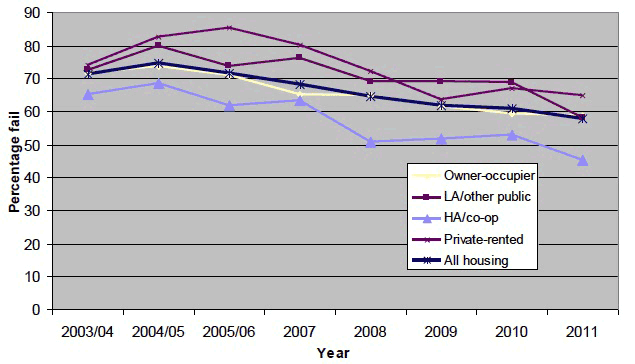
Source: Continuous SHCS
130. Table 32 shows that both tenure groups show an increased pass rate, but social housing is improving far faster overall. The proportion of dwellings failing the SHQS fell from around three quarters of both private and social sector dwellings in 2004/05 to 60% of private and 52% social failing in 2011.
131. The majority of dwellings that failed the SHQS failed the energy efficiency criterion. Full and efficient central heating[35] as well as minimum levels of thermal insulation - such as loft, hot water tank and wall insulation (where applicable) - are required. While this remains the most failed element, passes have increased across the board, most notably in the social sector where the pass rate has improved by 6 percentage points between 2009 and 2011.
Table 32 Scottish Housing Quality Standard element failure rate by tenure 2004/05 to 2011 (%)
| SHQS Element Failures (%) | ||||||||
|---|---|---|---|---|---|---|---|---|
| 2004/5 | 2005/6 | 2007 | 2008 | 2009 | 2010 | 2011 | ||
| All tenures | SHQS Overall Fail | 74 | 70 | 68 | 64 | 61 | 60 | 58 |
| Below Tolerable Standard | 1 | 0 | 1 | 1 | 1 | 4 | 3 | |
| Free from Serious Disrepair | 3 | 2 | 3 | 3 | 2 | 3 | 3 | |
| Energy Efficient | 57 | 54 | 52 | 51 | 48 | 48 | 45 | |
| Modern Facilities and Services | 23 | 22 | 19 | 14 | 13 | 12 | 11 | |
| Healthy, Safe and Secure | 28 | 27 | 24 | 24 | 21 | 20 | 19 | |
| Private Sector | SHQS Overall Fail | 74 | 71 | 67 | 66 | 61 | 59 | 60 |
| Below Tolerable Standard | 1 | 1 | 1 | 1 | 1 | 4 | 4 | |
| Free from Serious Disrepair | 3 | 2 | 4 | 3 | 2 | 3 | 3 | |
| Energy Efficient | 61 | 57 | 53 | 55 | 50 | 49 | 48 | |
| Modern Facilities and Services | 18 | 18 | 15 | 11 | 10 | 10 | 10 | |
| Healthy, Safe and Secure | 28 | 26 | 23 | 23 | 21 | 19 | 19 | |
| Social Sector | SHQS Overall Fail | 73 | 67 | 70 | 60 | 60 | 60 | 52 |
| Below Tolerable Standard | 0 | 0 | 1 | 0 | 1 | 2 | 1 | |
| Free from Serious Disrepair | 2 | 3 | 2 | 2 | 2 | 3 | 1 | |
| Energy Efficient | 48 | 46 | 48 | 40 | 42 | 44 | 36 | |
| Modern Facilities and Services | 38 | 32 | 29 | 22 | 21 | 15 | 12 | |
| Healthy, Safe and Secure | 28 | 29 | 27 | 25 | 22 | 23 | 18 | |
Source: Continuous SHCS
132. The proportion of dwellings failing the modern facilities and services criterion of the SHQS has also fallen since 2004/05 in both the social and private sectors. Overall it fell from 23% in 2004/5 to 11% of dwellings in 2011 (Table 32). The change from 2007 (19%) to 2011 (11%) is statistically significant.
133. Table 33 shows that the proportion of dwellings with more than one criterion failure has fallen since 2004/05. In 2011, 40% of dwellings failed on only one of the five higher-level criteria and 13% on two criteria. As a result, the number of SHQS element failures (as opposed to failing properties) has reduced from about 2.6 million to 1.9 million (Table 33)[36].
134. Table 34 shows that dwellings in rural areas are significantly more likely to fail the SHQS than in urban areas.
Table 33 SHQS criterion failures 2008-2011 (000s and Column %)
| SHQS Criterion Failures | 2004/5 | 2005/6 | 2007 | 2008 | 2009 | 2010 | 2011 | |||||||
|---|---|---|---|---|---|---|---|---|---|---|---|---|---|---|
| 000's | % | 000's | % | 000's | % | 000's | % | 000's | % | 000's | % | 000's | % | |
| No failures/ unobtainable | 605 | 26 | 692 | 30 | 750 | 32 | 838 | 36 | 915 | 39 | 951 | 40 | 1,019 | 43 |
| 1 Failure | 1,025 | 45 | 991 | 43 | 1,008 | 44 | 980 | 42 | 988 | 42 | 938 | 40 | 942 | 40 |
| 2 Failures | 484 | 21 | 456 | 20 | 404 | 17 | 376 | 16 | 343 | 15 | 346 | 15 | 301 | 13 |
| 3 Failures | 162 | 7 | 162 | 7 | 140 | 6 | 124 | 5 | 90 | 4 | 97 | 4 | 86 | 4 |
| 4 Failures | 24 | 1 | 13 | 1 | 11 | 0 | 10 | 0 | 8 | 0 | 20 | 1 | 17 | 1 |
| 5 Failures | 1 | 0 | 1 | 0 | 1 | 0 | 2 | 0 | 0 | 0 | 6 | 0 | 4 | 0 |
| Failures sub-total | 1,696 | 74 | 1,622 | 70 | 1,564 | 68 | 1,493 | 64 | 1,429 | 61 | 1,407 | 60 | 1,349 | 57 |
| Total SHQS criterion failures | 2,578 | 2,444 | 2,286 | 2,156 | 1,976 | 2,031 | 1,888 | |||||||
| Total dwellings | 2,301 | 100 | 2,315 | 100 | 2,314 | 100 | 2,331 | 100 | 2,344 | 100 | 2,357 | 100 | 2,368 | 100 |
| Sample size | 3,093 | 3,147 | 3,033 | 3,015 | 3,346 | 3,115 | 3,219 | |||||||
Source: Continuous SHCS
Table 34 SHQS urban/rural breakdown (000s and %)
| Urban | Rural | Unweighted | |||
|---|---|---|---|---|---|
| 000's | % | 000's | % | ||
| Pass | 836 | 43 | 145 | 37 | 1,321 |
| Fail | 1,101 | 57 | 249 | 63 | 1,855 |
| Total | 1,970 | 100 | 398 | 100 | 3,219 |
| Unweighted Sample size | 2,462 | 714 | |||
Source: SHCS 2011
5.2 Dampness and Condensation
135. 'Any condensation' and 'Any rising or penetrating damp' can cover anything from a small damp patch or area of condensation on a single wall in one room (caused for example by ineffective ventilation whilst cooking) to prevalence throughout a dwelling, so is not necessarily a serious housing quality issue in all cases.
136. Rising damp is the result of defective or missing damp proof coursing leading to water leaching into the building fabric. Penetrating damp is usually the result of a defect in the building fabric, such as damage to the walls or roof, water ingress due to damaged seals on doors or windows or damp as a result of leaking plumbing.
137. Table 35 and Table 36 indicate that just over 1 in 10 dwellings had condensation in at least one room, whilst few dwellings in Scotland suffered from either rising or penetrating damp (around 1 in 30). These figures are largely unchanged from those reported from 2002 to 2010.
Table 35 Presence of condensation in dwelling (000s and %)
| Any condensation? | 000s | % | unweighted Sample size |
|---|---|---|---|
| None | 2,106 | 89 | 2,871 |
| Some | 262 | 11 | 348 |
| Total | 2,368 | 100 | 3,219 |
Source: SHCS 2011
Table 36 Presence of rising or penetrating damp in dwelling (000s and %)
| Any rising or penetrating damp? |
000s | % | Sample size |
|---|---|---|---|
| None | 2,289 | 97 | 3,095 |
| Some | 79 | 3 | 124 |
| Total | 2,368 | 100 | 3,219 |
Source: SHCS 2011
138. Data on the state of disrepair of each dwelling is gathered in the physical inspection part of the SHCS. For clarification, the definition of 'disrepair' here is not the same at that measured in SHQS (section 5.1 above) which requires a property to be 'free from serious disrepair' so the numbers and percentages will be different from the SHQS data[37].
139. A range of elements - both internal and external - are assessed for the presence of disrepair, the urgency of disrepair (for external and common elements only), the extent of disrepair and in some cases the residual life of the element. These assessments allow an overall picture of the state of dwelling disrepair to be built up. We can therefore estimate the extent of disrepair of various types in Scotland's occupied housing stock. Definitions of the different types of disrepair are given in paragraph 189.
Table 37 Presence of any disrepair by age of dwelling, tenure and urban/rural indicator (000s and Row %)
| No disrepair | Disrepair | Total | Sample size | ||||
|---|---|---|---|---|---|---|---|
| 000s | % | 000s | % | 000s | % | ||
| Age of Dwelling | |||||||
| Pre-1919 | 37 | 8 | 422 | 92 | 459 | 100 | 590 |
| 1919-1944 | 21 | 7 | 281 | 93 | 303 | 100 | 422 |
| 1945-1964 | 37 | 7 | 486 | 93 | 523 | 100 | 747 |
| 1965-1982 | 94 | 17 | 471 | 83 | 565 | 100 | 768 |
| Post-1982 | 225 | 43 | 294 | 57 | 519 | 100 | 692 |
| Tenure | |||||||
| Owner-occupier | 302 | 21 | 1,167 | 79 | 1,468 | 100 | 2,054 |
| LA/other public | 34 | 10 | 311 | 90 | 345 | 100 | 464 |
| HA/co-op | 46 | 17 | 226 | 83 | 272 | 100 | 355 |
| Private-rented | 32 | 11 | 251 | 89 | 283 | 100 | 346 |
| Private Sector | 334 | 19 | 1,417 | 81 | 1,751 | 100 | 2,400 |
| Social Sector | 80 | 13 | 536 | 87 | 617 | 100 | 819 |
| Urban/Rural | |||||||
| Urban | 343 | 17 | 1,627 | 83 | 1,970 | 100 | 2,498 |
| Rural | 71 | 18 | 327 | 82 | 398 | 100 | 721 |
| All Dwellings | 414 | 17 | 1,954 | 83 | 2,368 | 100 | 3,219 |
| Sample size | 559 | 2,660 | 3,219 | ||||
Source: SHCS 2011
140. 'Any disrepair' covers all disrepair, irrespective of extent or seriousness, and can therefore mean anything from a leaking bathroom tap to a missing roof.
141. Table 37 shows the presence of 'any disrepair' by age of dwelling. Just over eighty percent (83%) of dwellings in Scotland have some disrepair. Older dwellings are more likely to have some form of disrepair with 92% of those built before 1919 having some disrepair compared with 57% of dwellings built after 1982.
142. In the private sector, 81% of dwellings have some form of disrepair, compared to 87% of dwellings in the social sector.
143. Levels of 'any disrepair' in urban and rural areas are about the same.
144. For common and external elements the surveyor is asked to assess the urgency of disrepair. An urgent repair is one which, if not carried out, would cause the fabric of the building to deteriorate further and/or place the health and safety of the occupier at risk. Table 38 shows 'any disrepair' by 'urgency of disrepair'.
Table 38 Urgent disrepair in buildings with some disrepair (000s and Column %)
| Any urgent disrepair | Any Disrepair | Total | Sample Size | ||
|---|---|---|---|---|---|
| 000s | % | 000s | % | ||
| None | 904 | 46 | 904 | 38 | 1,226 |
| Some | 939 | 48 | 939 | 40 | 1,278 |
| Not Applicable | 108 | 6 | 513 | 22 | 702 |
| Unobtainable | 3 | 0 | 12 | 1 | 13 |
| Total | 1,954 | 100 | 2,368 | 100 | 3,219 |
| Sample size | 2,660 | 3,219 | |||
Source: SHCS 2011
145. Figure 15(a-c) shows the presence of urgent disrepair, disrepair to critical elements and extensive disrepair in dwellings which have some form of disrepair (i.e. dwellings which have 'any disrepair' as defined above).
146. Critical elements are those whose condition is central to a dwelling being wind and weather proof, structurally stable and safeguarded against further rapid deterioration. Paragraph 189 lists the critical elements. The figures for critical disrepair are shown in Table 39 against dwelling and household characteristics.
147. 'Extensive disrepair' is used to identify dwellings where the disrepair present is of relatively greater severity. A detailed definition of extensive disrepair is given in paragraph 189.
148. Urgent disrepair, extensive disrepair and disrepair to critical elements are all subsets of 'any disrepair'.
149. In just under half of dwellings (48%) with some form of disrepair, that disrepair is urgent. Three quarters of dwellings with any disrepair have some disrepair to critical elements whilst around a third (32%) suffer from extensive disrepair (Figure 15(a-c)).
Figure 15 Of those dwellings with any disrepair: (a) urgency of disrepair (b) some disrepair to critical elements and (c) some extensive disrepair (%)
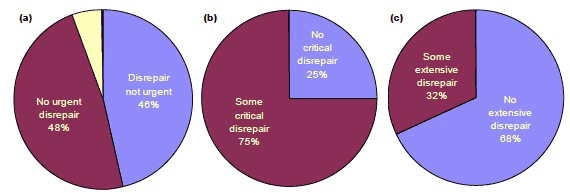
Source: SHCS 2011
Table 39 Disrepair to critical elements by age of dwelling, tenure and urban/rural indicator (000s and Row %)
| No disrepair to critical elements | Disrepair to critical elements | Total | Unweighted Sample size |
||||
|---|---|---|---|---|---|---|---|
| 000s | % | 000s | % | 000s | % | ||
| Age of dwelling | |||||||
| Pre-1919 | 105 | 23 | 355 | 77 | 459 | 100 | 590 |
| 1919-1944 | 74 | 25 | 228 | 75 | 303 | 100 | 422 |
| 1945-1964 | 149 | 28 | 374 | 72 | 523 | 100 | 747 |
| 1965-1982 | 221 | 39 | 344 | 61 | 565 | 100 | 768 |
| Post-1982 | 353 | 68 | 166 | 32 | 519 | 100 | 692 |
| Tenure | |||||||
| Owner-occupier | 605 | 41 | 863 | 59 | 1,468 | 100 | 2,054 |
| LA/other public | 91 | 26 | 254 | 74 | 345 | 100 | 464 |
| HA/co-op | 121 | 44 | 151 | 56 | 272 | 100 | 355 |
| Private-rented | 84 | 30 | 199 | 70 | 283 | 100 | 346 |
| Private Sector | 690 | 39 | 1,062 | 61 | 1,751 | 100 | 2,400 |
| Social Sector | 212 | 34 | 405 | 66 | 617 | 100 | 819 |
| Urban/Rural | |||||||
| Urban | 760 | 39 | 1,209 | 61 | 1,970 | 100 | 2,498 |
| Rural | 141 | 35 | 257 | 65 | 398 | 100 | 721 |
| All Dwellings | 902 | 38 | 1,467 | 62 | 2,368 | 100 | 3,219 |
| Unweighted Sample size | 1,205 | 2,014 | 3,219 | ||||
Source: SHCS 2011
150. Table 39 shows that the likelihood of experiencing disrepair to critical elements increases with the age of the dwelling. More than three-quarters of pre-1919 dwellings have some form of disrepair to critical elements, compared to about one third of those built after 1982.
151. Just over half of owner-occupied dwellings and just over half of dwellings rented from housing associations and housing co-operatives have some form of critical disrepair compared with 70% of those which are rented from a private landlord and 74% of those rented from a local authority or other public sector organisation. Overall, dwellings in the social sector are more likely to have disrepair to critical elements than those in the private sector.
152.Table 40 shows that 26% of dwellings in Scotland have some extensive disrepair. Following the same trend as 'any disrepair' and 'disrepair to critical elements', newer dwellings are less likely to suffer from extensive disrepair. Of dwellings built before 1919, 38% have some extensive disrepair compared with just 8% of those built after 1982.
153. Owner-occupied, Housing Association and housing co-operative dwellings are least likely to have some extensive disrepair.
Table 40 Extensive disrepair by age of dwelling, tenure and urban/rural indicator (000s and Row %)
| No extensive disrepair | Some extensive disrepair | Total | Unweighted Sample size |
||||
|---|---|---|---|---|---|---|---|
| 000s | % | 000s | % | 000s | % | ||
| Age of Dwelling | |||||||
| Pre-1919 | 285 | 62 | 174 | 38 | 459 | 100 | 590 |
| 1919-1944 | 196 | 65 | 107 | 35 | 303 | 100 | 422 |
| 1945-1964 | 372 | 71 | 151 | 29 | 523 | 100 | 747 |
| 1965-1982 | 423 | 75 | 142 | 25 | 565 | 100 | 768 |
| Post-1982 | 476 | 92 | 42 | 8 | 519 | 100 | 692 |
| Tenure | |||||||
| Owner-occupier | 1,143 | 78 | 325 | 22 | 1,468 | 100 | 2,054 |
| LA/other public | 232 | 67 | 113 | 33 | 345 | 100 | 464 |
| HA/co-op | 200 | 74 | 72 | 26 | 272 | 100 | 355 |
| Private-rented | 178 | 63 | 106 | 37 | 283 | 100 | 346 |
| Private Sector | 1,320 | 75 | 431 | 25 | 1,751 | 100 | 2,400 |
| Social Sector | 432 | 70 | 185 | 30 | 617 | 100 | 819 |
| Urban/Rural | |||||||
| Urban | 1,466 | 74 | 503 | 26 | 1,970 | 100 | 2,498 |
| Rural | 286 | 72 | 113 | 28 | 398 | 100 | 721 |
| All Dwellings | 1,752 | 74 | 616 | 26 | 2,368 | 100 | 3,219 |
| Unweighted Sample size | 2,399 | 820 | 3,219 | ||||
Source: SHCS 2011
154. For 57% of dwellings with some disrepair to critical elements the disrepair is urgent (Figure 16).
Figure 16 Urgent disrepair in dwellings with some form of disrepair to critical elements (%)
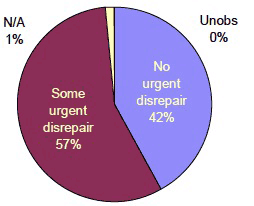
Source: SHCS 2011
155. In 66% of dwellings with extensive disrepair, the disrepair is classed as 'urgent' (Figure 17).
Figure 17 Urgent disrepair in dwellings with some form of extensive disrepair (%)
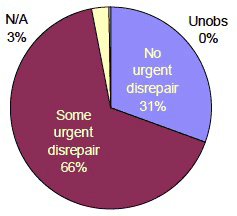
Source: SHCS 2011
156. Figure 18 shows the proportion of dwellings in each age group which experience 'any disrepair', 'disrepair to critical elements' and 'extensive disrepair'.
Figure 18 Any disrepair, critical element and extensive disrepair by age of dwelling (%)
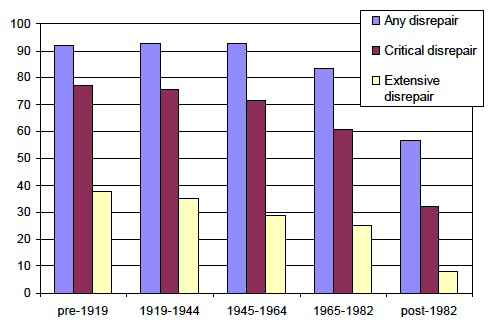
Source: SHCS 2011
Contact
Email: Ganka Mueller
There is a problem
Thanks for your feedback